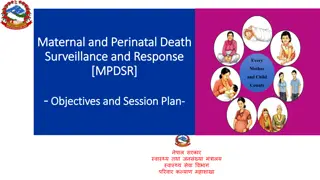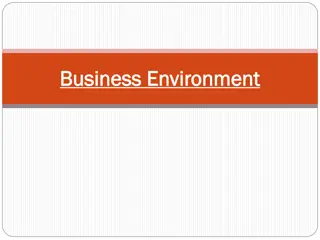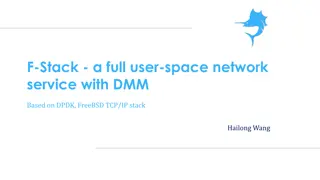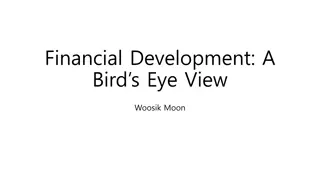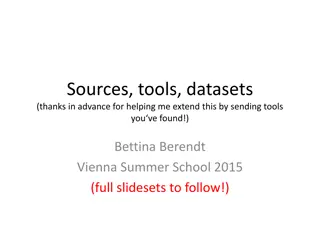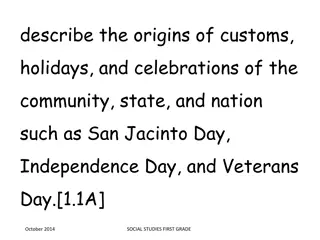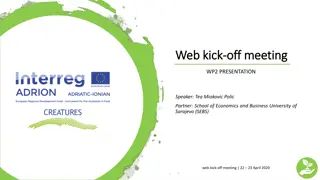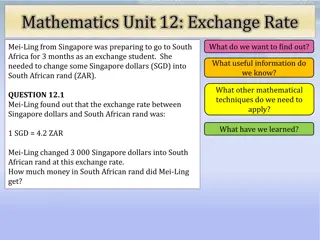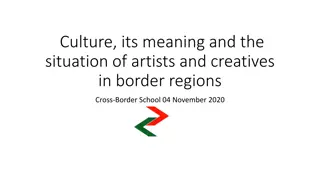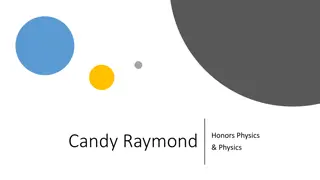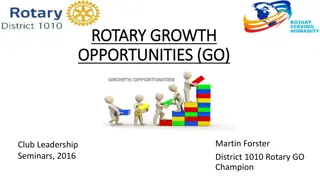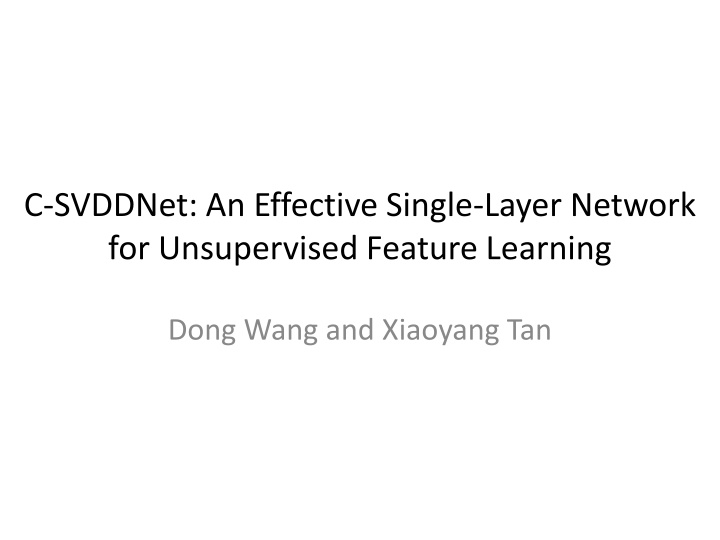
Effective Single-Layer Network for Unsupervised Feature Learning
"Discover the C-SVDDNet, a single-layer network designed for unsupervised feature learning. Learn how it outperforms traditional neural networks and explore the use of Support Vector Data Description for improved accuracy in classification tasks. Find out how local details in object representation impact network performance."
Uploaded on | 1 Views
Download Presentation

Please find below an Image/Link to download the presentation.
The content on the website is provided AS IS for your information and personal use only. It may not be sold, licensed, or shared on other websites without obtaining consent from the author. If you encounter any issues during the download, it is possible that the publisher has removed the file from their server.
You are allowed to download the files provided on this website for personal or commercial use, subject to the condition that they are used lawfully. All files are the property of their respective owners.
The content on the website is provided AS IS for your information and personal use only. It may not be sold, licensed, or shared on other websites without obtaining consent from the author.
E N D
Presentation Transcript
C-SVDDNet: An Effective Single-Layer Network for Unsupervised Feature Learning Dong Wang and Xiaoyang Tan
I. INTRODUCTION Learning good feature representation from unlabeled data is the key to make progress in recognition and classification tasks A representative method is the deep learning (DL) goal to learn multiple layers of abstract representations from data one typical DL method is convolutional neural network (ConvNet) consists of multiple trainable stages stacked on top of each other, followed by a supervised classifier Many variations of ConvNet network have been proposed for different vision tasks with great success
neural network Vs. single-layer feature learning neural network single-layer (K-means) principle one layer at a time on the lower level using unsupervised learning map the input data into a feature representation by associating each data point to its nearest cluster center only one parameter (# of clusters) very easy to use in practice Coates et al. shows that it is capable to achieve superior performance compared to Neural network method too terse no consider the non-uniform distribution of cluster size clusters containing more data likely with higher influential power not robust against the noise/outliers performance performance of single-layer learning has a big effect on the final representation drawback Neural network based single layer methods widely used have many parameters time consuming
Support Vector Data Description SVDD to measure the density of each cluster resulted from K-means clustering a widely used tool to find a minimal closed spherical boundary to describe the data belonging to the target class for a cluster of data, SVDD generate a ball containing the normal data except outliers use the distance from the data to each ball s surface instead of the center as the feature
local detail of the object representation parameters define the feature extraction pipeline have more impact on the performance K-means network with 4000 features achieve good performance on several benchmark datasets (better) But a very crude pooling size has to be adopted to condense the resulting feature maps large single-layer network highlighting global information of an object using large number of centroids explore alternative architecture with much smaller number of nodes and with much finer pooling size emphasize local details of object
II. PRELIMINARIES Unsupervised Feature Learning automatically discover useful hidden patterns/features in large datasets without labels learnt patterns can be utilized to create representations facilitate subsequent supervised learning
A typical pipeline for unsupervised feature learning train a set of local filters from the unlabeled training data given an input image, construct a set of feature maps for it using the learnt filters apply a pooling operation feature maps combined into a vector as the feature representation for the input image local filters contain important prior knowledge about the distribution of the data, plays a critical role in the feature encoding
K-means for Feature Mapping K-means divides data into a set of K clusters with Euclidean distance as similarity measure aims to minimize the sum of distance between all data to their corresponding centers K clusters used to produce a feature mapping if we have K clusters, the dimension of the resulting feature representation will be K
way for feature mapping hard coding triangle encoding (better) output 0 for the feature average distance to the centroid that has an above
Factors affect feature representation number of data point in each cluster distribution of data points in each cluster
Using SVDD Ball to Cover Unequal Clusters a ball is described by center a and the radius R goal of SVDD is to find a closed spherical boundary around the given data points KKT:
SVDD compute distance hk to the surface of each SVDD ball Ck
centered-SVDD Model ball may not align well with the distribution of data points in that cluster
KKT This objective function is linear to , and thus can be solved efficiently with a linear programming algorithm.
Encoding Feature Maps with SIFT Representation SIFT is a widely used descriptor in computer vision and is helpful to suppress the noise and improve the invariant properties of the final feature representation one problem of SIFT-based representation is its high dimensionality For example, if we extract 128 dimensional SIFT- descriptors densely in 250 feature maps with the size of 23 23 in pixel, the dimension of the obtained representation vector will be as high as over 16M (250 23 23 128 = 16, 928, 000)
divide each feature map into m m blocks extract an 8-bit gradient histogram from each block in the same way as SIFT does This results in a feature representation with dimension of m m 8 for each map significantly reducing the dimensionality while preserving rich information for the subsequent task of pattern classification
Multi-scale Receptive Field Voting exploit multi-scale information for better feature learning A multi-scale method is a way to describe the objects of interest in different sizes of context patches of a fixed size can seldom characterize an object well - actually they can only capture local appearance information limited in that size information at different levels is valuable in that they are not only discriminative by itself but complementary to each other as well
naive way to obtain multi-scale information by using receptive fields of different sizes fetch patches with Si Si , i = 1, 2, 3 squares in size from training images and use these to train dictionary atoms with corresponding size through K-means
feature extractors similar to those using a typical ConvNet At each scale train several networks with different pooling size
Classification train a separate classifier on the output layer of the corresponding network (view) according to different receptive sizes and different pooling sizes then combine them under a boosting framework
assume the total number of categories is C, and we have M scales (with K different number of pooling sizes for each scale), then we have to learn M K C output nodes These nodes are corresponding to M K multi-class classifiers. Let us denote the parameter of the t th classifier t RD C (D is the dimension of feature representation) as t = [wt1, wt2, ..., wtC ], where wtk is the weight vector for the k-th category. We first train these parameters using a series of one-versus-rest L2-SVM classifiers, and then normalize the outputs of each classifier using a soft max function
Datasets 4 object datasets MINST, NORB, CIFAR-10, STL-10 MINST: popularly used in pattern recognition NORB: used to evaluate the scalability of many learning algorithms CIFAR-10: much noisy background STL-10: popularly used to evaluate the algorithms of unsupervised learning
Experiment Settings Whiten Preprocess I. decorrelation transformation Common Parameters: I. #clusters: <=500 II. receptive field size: 5 x 5(default), 7 x 7, 9 x 9 III. average pooling size: 4 x 4, 1 x 1, 3 x 3 IV. of C-SVDD: 1(default), 0.005
Experiment Settings continued K-means: I. C-SVDD: I. C-SVDDNet: I. MSRV + C-SVDDNet: I. multi-scale Receptive Field voting + C-SVDDNet K-meansNet: I. K-means + SIFT representation "triangle" encoding method as baseline with K-means encoding "triangle" encoding method as baseline with C-SVDD encoding C-SVDD + SIFT representation encoding
1st Dataset MINST consists of grey valued images of handwritten digits between 0 and 9
MINST Process stage: 1. Size-normalized, centered into 28 x 28 pixel 2. 400 atoms for feature mapping 3. Pooling 4. Extract SIFT features: break each feature map into 9 blocks 5. Multi-scale receptive voting: I. Receptive fields: 5 x 5, 7 x7, 9 x 9 II. Pooling size: i.e. 1 x 1, 2 x 2 III. I combine with II to botain 6 different representations 6. 7. value : 1 K-fold cross validation or specific evaluation protocol: I. training sample size: 60,000; test sample size : 10,000
Experimental Results(MINST) Result 1: MSRV + C-SVDDNet achieves a low error, 0.35%, highly competitive to other methods. 35 misclasification among 10, 1000 test examples. Confused even for human beings.
Experimental Results(MINST) Result 2 : C-SVDDNet with smaller number of filters, reduces error rate by 65%, compared with K-means network. Result 3: At least on this dataset, representation is worth to be emphasized more than global aspects using large number of filters and large pooling size.
2nd Dataset NORB I. Mnay feature learning algorithms use this database as a benchmark to evaluate their scalability Before the proposed method, fine-tuned K-means single-layer network was previously shown yield better performance consists of large amounts of object images 5 classes: animals, humans, planes, trucks, and cars II. III. IV.
NORB Process step: 1. 2. 3. 4. 5. 6. Normalized-uniform and centered: 96 x 96pixel Resize all images to 64 x 64 pixel 400 atoms Average Pooling Extract SIFT features: break each feature map into 4 x 4 block size Multi-scale receptive voting: I. Receptive fields: 5 x 5, 7 x7 II. Pooling size: i.e. 2 x 2, 3 x 3, and 4 x 4 III. I combine with II to botain 6 different representations for each input image 7. 8. value : 1 Specific evaluation protocol training sample size: 29,160 images; test sample size : 29,160 images
Experimental Results(NORB) MSRV + C-SVDDnet achieves the highest accuracy: 98.64% on a huge dataset nearly 60 thousands data compared with previously shown that K-means(4000 features) has a better performance than aforementioned methods, MSRV + C-SVDDnet achieve the state of the art performance(only 400 atoms).
3rd Dataset CIFAR-10 I. II. contains 10 classes, with 6,000 images per class. III. within each class, images vary in object positions, objection scales, colors, and textures IV. Images background cluttered, low resolution consists of 60,000 32 x 32 colour images
CIFAR-10 Process step: 1. Larger dictionary: 1,200 atoms 2. Average Pooling 3. Extract 32-bit SIFT features: break each feature map into 4 blocks 4. Multi-scale receptive voting: I. Receptive fields: 5 x 5, 7 x7, 9 x 9 II. Pooling size: i.e. 1 x 1, 2 x 2 III. I combine with II to botain 6 different representations for each input image 5. 6. value : 0.05, remove noise, larger SVDD balls Specific evaluation protocol training sample size: 50,000 images; test sample size : 10,000 images
Experimental Results(CIFAR-10) MSRV + C-SVDDnet achieves the high accuracy: 85.30% close to the state of the art performance.
Experimental Results(CIFAR-10) Another result from table: C-SVDDNet, achieve an accuracy 82.64%, outperforms other multi-layer architecture systems, such as PCANet, Convolutional Kernel Networks. Possible explanation from table: SIFT encoding leads to more robust representation.
4th Dataset STL-10 I. 100,000 unlabeled images, 13,000 labeled images(10 object classes), where 5,000 images for training, 8,000 for training II. images size : 96 x 96 pixel III. Images background cluttered, vary in scales, poses.
STL-10 Process step: 1. Specific evaluation protocol I. Original 5,000 training images are partitioned into 10 overlapped folds, with 1,000 images in each fold II. Each fold: training sample size: 1,000, testing: 8,000 III. Evaluation across 10 folds 2. Dictionary: 500 atoms 3. For unsupervised feature learning, randomly select 20, 000 unlabled data 4. Spatial pooling: 4 x 4 5. Extract SIFT representation 6. Multi-scale receptive voting: I. Receptive fields: 5 x 5, 7 x7 II. Pooling size: i.e. 2 x 2, 3 x 3, 4 x 4, 5 x 5, 6 x 6 III. I combine with II to botain 10 different representations for each input image 7. value : 1
Experimental Results(STL-10) MSRV + C-SVDDnet achieves the highest accuracy: 68.23% around, outperforms the current best performer (Deep Feedforward Networks) on the challenging dataset, with 2.6% improvement in accuracy
Experimental Results(STL-10) Another result from table: I. C-SVDDNet, achieve an accuracy 65.62%, outperforms in RBM, Selective Receptive Fields, and Discriminative Sum-Product Networks. II. C-SVDDNet, better than K-meansNet with higher 3.0% improvement in accuracy.



